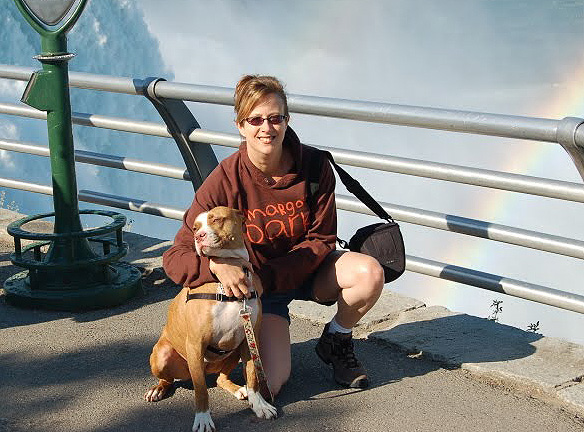This article made possible by StubbyDog.org.
When journalist and animal welfare advocate Michelle Sathe turned 40, she hit the road with adoptable pit bull Loren to explore 29 states and examine the sad reality facing beleaguered “bully” breeds in America’s shelters. The resulting book, “Pit Stops,” is on sale now and Michelle is setting off on her second road trip with another adoptable pit bull. Here, StubbyDog chats with Michelle about her journeys.
What made you take this trip? And why did you bring Loren?
I took this trip for several reasons. First, I was turning 40 and always wanted to take the Great American Road Trip. Second, I wanted to bring attention to the plight of pit bull and homeless pets.
Originally, I was going to take my Staffie mix Buster on the road, but after volunteering at The Brittany Foundation, a no-kill rescue in Agua Dulce, Calif., I realized that one of its dogs needed a vacation way more than he did. I had fallen in love with Loren, who was just the most affectionate dog on the planet. Instinctively, I knew she would make a fantastic companion for me and a great ambassador for bully breeds.
My hope was the once people had a positive, hands-on interaction with a pit bull that they wouldn’t be able to buy into the misconception they are not good dogs because, of course, they are fantastic.
Did you encounter prejudice against Loren being a pit bull? How did you deal with it?
For the most part, people were open-minded to meeting Loren. Many of the people we met on the road were already pit bull owners or lovers and loved that we were trying to help the breed’s image.
It was when Loren and I were in big cities that I was really surprised. We’d come across some pretty tough-looking characters that would actually cross the street to get away from us. They were scared, which was strange to me, because Loren and I are about the most non-threatening pair on the planet.
Sadly, while in Virginia, a woman took one look at Loren and ran the other way, saying, “Oooh … .” It breaks my heart that someone can discriminate against a dog with one look.
Did you have any problems finding lodging because of Loren?
We didn’t have any problems with lodging. I had researched dog-friendly hotels on dogfriendly.com that didn’t have any breed or weight restrictions. For the most part, we stayed at Motel 6, La Quinta Inns and Suites, Red Roof Inn and Super 8. Only once was I asked to fill out a form on Loren and it wasn’t because the staff was prejudiced, it was hotel policy. Loren was in the car, so they had no idea what kind of dog she was.
Did you avoid BSL states, and did you research which ones where BSL states before your journey?
I was a little naïve about BSL prior to this trip and didn’t really know to research areas where Loren may not be welcome. After we stayed at Animal Farm Foundation in New York, the staff there advised me not to go through Ohio, so I rerouted through Kentucky.
Planning for my trip with Kara, I have been much more alert to BSL. Originally, we were going to go to Arvada, but I ultimately decided against it because I didn’t want to go anywhere near Denver. That is not a good place for pit bulls. Several people told me that Arkansas has BSL, so I decided not to chance that, either.
You stopped at various shelters along the way? What was your mission in doing that?
Yes, we stopped at several shelters, from Alabama to New York. This was to research and understand the issues facing pit bulls all across the country, not just in California, where Loren and I are from. I wanted to grasp why bully breeds are so prevalent in shelters and found out all the disturbing reasons firsthand: backyard breeding, abuse, neglect, dog fighting, etc. It varies from area to area, but for the most part, I saw that at least 50 percent, often more like 80 percent, of the dogs in shelters are bully breeds.
This was very challenging for me. I volunteer at a no-kill rescue because I can’t handle being so close to the reality that adoptable animals are killed. However, I don’t blame the shelter workers whatsoever, at least not the ones I met on the trip, who were doing their best to help these animals under impossibly difficult circumstances.
Can you tell me of a wonderful story concerning pit bulls that came about because of your trip with Loren?
Honestly, the most rewarding thing about the trip and the subsequent book has been educating people outside the rescue circle about pit bulls and homeless pets. I have rescue friends that have passed on a copy of “Pit Stops” to someone who had no idea what was going on with these dogs. Now they’re like, “I get it.” If everyone got it, perhaps the senseless killings and abuse of pit bulls will stop.
Loren’s story has a happy ending. Can you tell us about that?
Yes. The last chapter is called “Third Time’s a Charm” because that’s what it took for Loren to find her truly forever person. Honestly, I couldn’t have dreamed of a better ending for Loren. She waited a long time and went through a lot, but finally, her prince did come.
What is your fondest memory of your trip?
Seeing the New York skyline took my breath away. It seemed like we would never get there, but we did, one mile at a time. Loren trying frozen custard in Pittsburgh was a highlight. She was like a little kid, lapping it up. That image still makes me laugh. Just spending quality time with Loren was a gift, seeing the amazing landscapes this country has to offer with her.
The faces I saw at shelters continue to haunt me. I wanted to take all those animals home, especially when I realized how many wouldn’t make it out alive. It was a tremendous wake-up call for me. Though my heart was heavy, I felt it was my duty to try and tell their truth in “Pit Stops.” To give the voiceless a voice.
On the flip side, meeting the incredible animal welfare volunteers across America continues to inspire me two years later. I’ve made many friendships from that trip that continue to this day. Whenever I need a shoulder to cry on and it gets too hard, I turn to them. They give me hope and strength.
You are starting another journey with Kara in May. Please tell us about that.
Kara’s story is fairly typical for bully breeds. She was used as a breeder, then dumped at a high-kill shelter, pregnant. Once her pups were adopted, Kara was slated to be killed until a wonderful shelter volunteer/foster named Kyle Harris took her in. Kara currently lives in Kyle’s well-equipped garage kennel. It’s quite nice by rescue standards, but it’s not the same as being a family pet.
Despite all she’s been through, Kara is a sweetheart who loves people and other dogs, too. For all those reasons, I chose Kara to be the “Pit Stops” book tour bully breed ambassador. I’m also hoping Kara will find a home by the end of our trip because of the exposure.
In between signings, Kara and I will meet with rescuers and go on adventures, which will make up “Pit Stops 2: Adventures with Kara,” due for release in spring or summer of 2012.
Will you continue to take trips with adoptable pit bulls?
It seems to be becoming a tradition with me. LOL. There are no plans for a trip after this, but don’t count it out. I still need to explore the New England states and maybe even Canada. Who better to take along than an awesome adoptable pit bull?
You can also follow Michelle and Kara’s journey on her blog.









